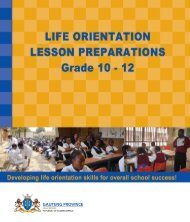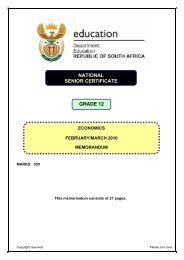Life Science Grade 11
Life Science Grade 11
Life Science Grade 11
Create successful ePaper yourself
Turn your PDF publications into a flip-book with our unique Google optimized e-Paper software.
<strong>Grade</strong> <strong>11</strong> <strong>Life</strong> <strong>Science</strong>s Lesson PlansGRADE <strong>11</strong> SUBJECT <strong>Life</strong> <strong>Science</strong>s WEEK 8 TOPIC Animal diversity: Annelida, Arthropoda, Chordata Lesson 3LESSON SUMMARY FOR: DATE STARTED:DATE COMPLETED:Content: (CAPS p 41)With respect to the following phyla: Annelida, Arthropoda, Chordata discuss the following features of their body plan:• Symmetry and cephalisation;• The number of tissue layers developed from the embryo;• The number of openings in the gut;• Coelom and blood systems.LESSON OBJECTIVESThe learner must be able to:• Describe the type of habitat that Annelida, Arthropoda, Chordata are found in• Explain the type of symmetry exhibited by the phyla Annelida, Arthropoda, Chordata.• Discuss the types of tissue layers that Annelida, Arthropoda, Chordata possess.• Describe the type of digestive system found in Annelida, Arthropoda, Chordata.• Discuss the presence or absence of a coelom in the Annelida, Arthropoda, Chordata.• Describe the type of blood system found in the Annelida, Arthropoda, Chordata.• Name and example of a Annelida, Arthropoda, Chordata.TEACHER ACTIVITIES LEARNER ACTIVITIES TIMING RESOURCES NEEDED1.1 Introduction• Refer to the previous two lesson and remind learners thata body plan for an animal includes symmetry, and tissuelayers (the endoderm, mesoderm, and ectoderm intriploblastic animals and endoderm and ectoderm indiploblastic animals), the presence or absence of a bodycavity and the presence or absence of a through gut.Learners listen to discussion, providingdefinitions to the concepts: asymmetrical,bilaterally symmetrical, radially symmetrical,diploblastic, triploblastic, coelom, blind gutand through gut.10 minChalkboard/OHT2.2 Main Body (Lesson presentation)Jigsaw group work. Divide the class into small groups of threelearners per group. Each group is to become an expert onone of the animal phyla: Annelida, Arthropoda, Chordata.Each group is to use their text book to find information ontheir particular group of the following:• Symmetry and cephalisation;• The number of tissue layers developed from the embryo;• The number of openings in the gut;• Coelom and blood systems.Learners work in expert groups gatheringinformation on the body plan of theirparticular phylum. Once they have theinformation they form new groups where theyshare their information and get informationfrom experts on the other two phyla.25 minSolutions for all p 103-107Study and master p126-135Understanding <strong>Life</strong> <strong>Science</strong>s p95-100• http://www.pbs.org/kcet/shapeoflife/resources/index.html• (click on Body Plan ComparisonChallenge)• Understanding <strong>Life</strong> <strong>Science</strong>s Act.3.3.5 pg. 261Term 1 Page 74© Gauteng Department of Education (CAPS version)







